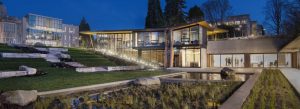UBC’s Approach to Indigenous “Inclusion”
My Object: The Indian Residential School History and Dialogue Centre
GRSJ 422
Nimrit Toor

Analysis of Object:
- The centre is located below IKB across from Koerner’s library. It is technically central but is hidden.
- The space was empty with only two headphones and two Ipads to interact with. Not a lot of artwork on the walls and there were many people sitting outside the building on the grass hill.
- The area where the centre is located is very busy and there are a lot of people walking around it.
‘Not a trophy for UBC’:
- This article states that this beautiful building is mainly empty
- They are understaffed and are only able to attain “a fraction of the records” they were promised the centre would have access to
- These records included histories, documents and testimonies that are apart of the Indian Residential School System
- This lack of resources makes it very difficult for the centre to be successfully open and accessible
- Right now it sits like a trophy but is meant to be a “serious place that has to make an impact, and to do that is going to take some serious effort and it’s not there yet”
Quotes:
- “Although the discourses and guidelines surrounding diversity are not completely ineffective, nonetheless they do not necessarily lead to the effects they name and promise, but are still perceived as performative (Ahmed, 2006, p. 104)” (Dhawan, Varela & Berlin, 2016, p. 21)
- “Having an institutional aim to make diversity a goal can be a sign that diversity is not an institutional goal” (Ahmed, 2012, p. 23)
- “… For Indigenous inclusion on behalf of both the college and the university, it ultimately sought to add Indigenous people into pre-existing university structures, inserting them into departments where they are likely to be the only Indigenous scholars in their respective unit” (Gaudry & Lorenz, 2018, p. 219)
Question: What does it mean for Santa Ono to push the Official Apology of UBC to the opening of the centre? In the eyes of the institution, what would the downside be of giving the speech on the first official date months earlier?
Group Questions:
- How does the University benefit by marketing diversity that is performed by minorities and Indigenous students?
- In what ways does UBC promote diversity and decolonization initiatives in order to demonstrate the universities “multiculturalism” without acknowledging and attempting to change systemic issues within the University’s structure, and history?
- What role do the programs and the research that is valued, funded and produced by the University reinforce who has been both historically and presently, welcomed or seen as “belonging” on UBC’s campus?
Works Cited: Ahmed, S. (2012). On Being Included: Racism and Diversity in Institutional Life. Durham: Duke University Press.
- Chase, B. (n.d.). ‘Not a trophy for UBC’: Five months after opening, Indian Residential School History and Dialogue Centre is short-staffed, undersupported and effectively empty. Retrieved from https://www.ubyssey.ca/news/irshdc-a-building-not-yet-a-centre/
- Dhawan, N., Varela, M. D., & Berlin, A. S. (2016). “What Difference Does Difference make?”: Diversity, Intersectionality and Transnational Feminist Politics. Wagadu: A Journal of Transnational Women’s and Gender Studies, 16, 11-39.
Gaudry, A., & Lorenz, D. (2018). Indigenization as inclusion, reconciliation, and decolonization: Navigating the different visions for indigenizing the Canadian Academy. AlterNative: An International Journal of Indigenous Peoples, 14(3), 218-227.